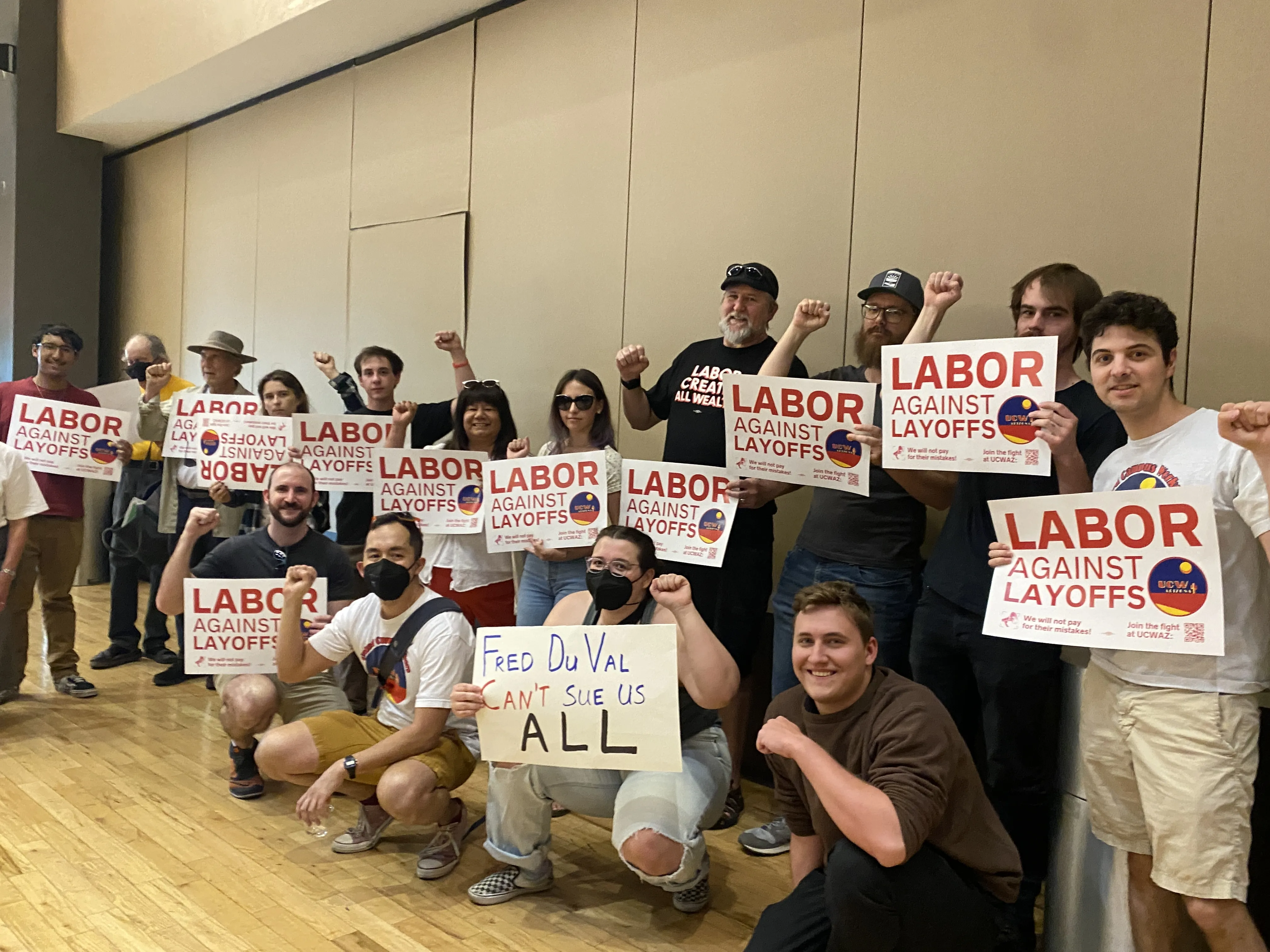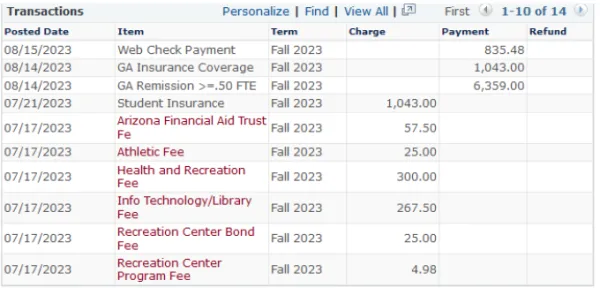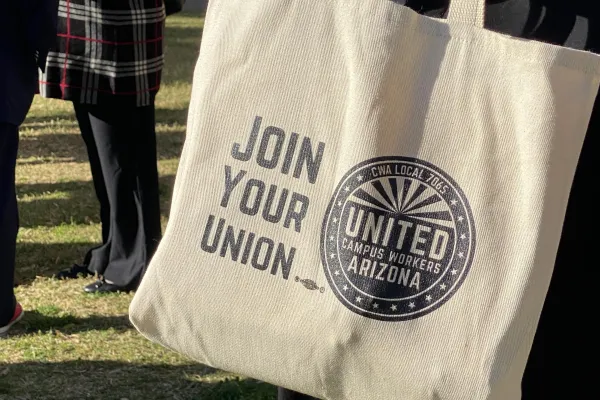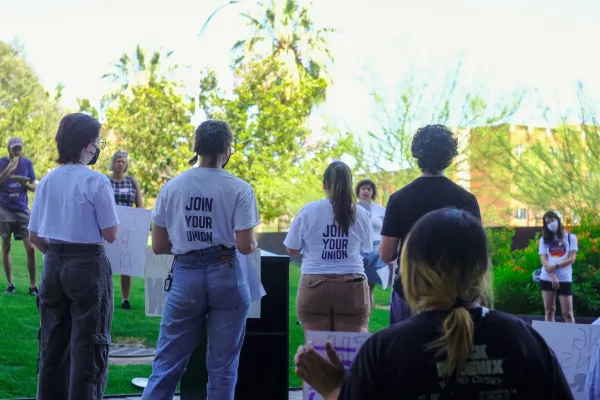Benefits of Joining Your Union

When we work together, and when we’re mindful of the ways bosses and their allies exploit our differences to keep us divided, workers from all races, backgrounds, abilities, and cultures can do a lot. We can expose the alliances between greedy managers and paid political figures, we can recruit and partner with a larger, activated group of people, and we can win.
Our Wins
When we fight, we win.
Wage Increases
| Job Protection
Shared Power in University Governance Structures
|
Fee-Waiver Win at the University of Arizona
UCWAZ, CWA Local 7065, and partners in the University of Arizona's (UA) Graduate and Professional Student Council (GPSC) pulled off a historic financial win for graduate students at UA. Student fees have now been bundled with tuition, so anyone receiving tuition remission will have this applied to their fees. Several thousand TAs, RAs, and GAs are now free of paying hundreds and thousands of dollars of fees.
 |  |
|---|---|
One of our graduate student members at the University of Arizona showed a snapshot of life before and after our fee waiver win. The picture on the left shows our member's Fall 2023 student fees. The picture on the right shows our member's Fall 2024 student fees, which have been bundled and are significantly fewer. | |
Tuition remission means that the University pays for your tuition as part of your package as a TA, RA, or GA. Thus, GAs, TAs, and RAs make poor wages because half of their “salary” is in wages and the other half is in tuition remission. Essentially, the University tries to reduce pay for grad students by paying their tuition. Student fees come out of the already slim wages you’re paid, rather than already being counted in the “tuition remission.” Bundling the fees into tuition remission means students get to keep their paid wages in their pocket rather than getting deducted more wages in the form of fees.
This saves thousands of graduate students at UA between $800 and $1,000 per semester. Over the course of their time in their programs, graduate students will now save between approximately $4,500 to $7,500.
Period Equity Win
The union secured a major victory for all workers on healthcare and gender equity issues at UA. As of Summer 2024, all first floor campus bathrooms (excluding the student union and gyms) will feature menstrual products (sustainable pads and tampons) and product dispensers.
HB2735 Veto Protects Worker-Led Governance Statewide
After a pitched-battle nationally over faculty governance, Arizona became the next victim of this right wing attack on worker governance and power. Through the Arizona Board of Regents, the State legislature passed a bill that would dismantle the rights of faculty to govern internally at their institutions (a right originally enshrined in the AZ state constitution). However, after tireless campaigning and advocacy by UCWAZ and the Arizona AFL-CIO, Governor Hobbs vetoed this proposed legislation.
Read Governor Hobbs' Veto Letter
Overpay Issue at ASU
Graduate student RA/TAs at ASU had been “overpaid” over the course of several months due to administrative errors. ASU was demanding that students pay back anywhere between $5,000 to $11,000. UCWAZ and other student groups organized against this and pushed back so that students weren’t forced to pay back money they didn’t have.
Contingent Faculty Win at the University of Arizona
The University of Arizona will now be awarding more multi-year appointments to “full rank” Career-Track Faculty (also known as Contingent Faculty)! On Monday, January 27th, Provost Ron Marx reported that all “full” rank contingent faculty will move from one-year contracts to multi-year contracts this coming academic year. This is an important win toward job security for Contingent Faculty and multi-year contracts for all ranks, made possible by proud union members across campus roles. Higher-ed faculty’s working conditions are students’ learning conditions, period.
Access to Funds
As UCWAZ, CWA Local 7065 members, you have access to several of our union's funds.
Legal Defense Fund
Our Legal Defense Fund is a collection of funds available to any member* statewide experiencing workplace discrimintation, wrongful termination, wage disputes, and more. You can learn more about the fund below.
Our Legal Defense Fund*Non-voting community supporters are exempt from receiving Legal Defense funds.
Solidarity Fund
Each month, many of our members pay more in dues than necessary to contribute to our solidarity fund. This fund is available to members who can't otherwise afford dues, who are struggling with rent or unexpected costs, and more. To access the solidarity fund, email [email protected] with the subject line "Solidarity Fund Request."
We Host Events For Members and Open to the Public
Every month, we host events open to the public and our union members. You can find upcoming events below.
Where Your Dues Really Go
Your dues make our organizing work possible. Dues support the operational expenses of our organization including resources, training, communications, lobbying and legal services, and more.
Members shall pay monthly dues in an amount recommended by the Executive Committee and ratified by the membership by majority vote. (UCWAZ By-Laws, approved 2021)
Below is a breakdown of how your dues fund your union, by percentage. Each umbrella term is followed by a breakdown of fund disbursement in each area with a brief explanation.
Organizers - 67.3% | This includes employees’ salaries and benefits, office supplies, software, equipment and technology. |
Swag - 1.4% | This includes printing and mailing flyers, postcards, posters, and wearable swag like shirts, totes, buttons, and stickers. |
Legal Defense Fund - 3.6% | We help to cover legal services for members’ employment-related claims. |
Per-Capita Dues to CWA - 14.4% | This is our share of CWA’s national strike growth funds. |
Organizing Expenses - 7.5% | This includes hosting union socials and other public-facing events, travel costs for members to attend conferences and local-wide events, and space fees. |
Mutual Aid & Solidarity Fund - 1.9% | This money goes into mutual aid for community members and the solidarity fund which pays members dues who cannot otherwise afford to pay. |
Accountant & Legal Fees - 2.7% | Legal fees for our annual tax-filing. |
Contributions to Local Organizations - 0.9% | These are approved contributions to local-adjacent organizations, including MALF, PALF, and HELU. |
You can view and download our one-pager explaining your dues breakdown by clicking the button below.
Where your dues really go
Ready to Join?
Join your labor union, United Campus Workers of Arizona. Build solidarity and worker power in your workplace. Together, we are stronger!
Join Your Union
Still have some questions? Understandable! You can read through some of our most frequently asked questions about your rights to join a union in Arizona, who can join, collective bargaining, and more on our Frequently Asked Questions (FAQs) page.
FAQs



